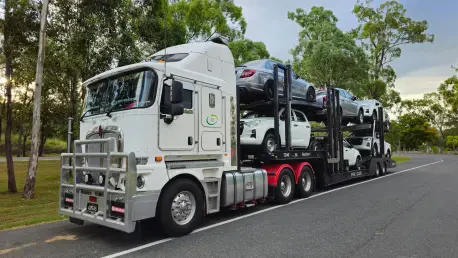In an industry as vital and complex as trucking, where safety, efficiency, and cost management are paramount, artificial intelligence (AI) is emerging as a transformative force in insurance underwriting. This technology is not just tweaking existing systems but fundamentally reshaping how insurers evaluate risk, set premiums, and interact with fleets. Gone are the days when broad, generalized risk pools dictated pricing, often penalizing safer operators for the shortcomings of others. Today, AI harnesses real-time data from tools like telematics and electronic logging devices (ELDs) to craft individualized risk profiles that reflect actual performance. This shift promises a fairer, more precise approach, but it also brings challenges, from regulatory hurdles to adoption hesitancy in a traditionally cautious sector. As AI continues to evolve, its integration into trucking insurance underwriting is proving to be a game-changer, setting the stage for a more data-driven and responsive industry.
The implications of this technological wave extend far beyond mere numbers, as AI is streamlining cumbersome processes, enhancing safety measures, and even influencing how claims are defended against costly legal outcomes. Yet, the path forward isn’t without obstacles, as varying state regulations and the need for unbiased systems complicate widespread implementation. This exploration delves into the multifaceted ways AI is redefining underwriting, from personalizing risk assessment to shaping future industry standards, offering a glimpse into a rapidly evolving landscape.
The Shift to Personalized Underwriting
Redefining Risk Assessment
AI is revolutionizing the traditional framework of trucking insurance by dismantling the outdated practice of grouping fleets into broad risk categories, a system that often forced safer operators to bear the cost of riskier ones. By tapping into a wealth of real-time data sourced from telematics, ELDs, dashcams, and advanced driver assistance systems, insurers can now evaluate risk on a per-client basis. This detailed approach ensures that premiums are aligned with a fleet’s specific performance metrics rather than industry-wide assumptions. Companies pioneering this shift emphasize that such precision not only promotes fairness but also incentivizes better driving habits, as fleets see direct financial benefits from maintaining high safety standards. The move away from one-size-fits-all models marks a significant departure from past practices, positioning AI as a cornerstone of modern underwriting strategies that prioritize accuracy over generalization.
This personalized risk assessment also fosters a deeper connection between insurers and fleets, as data transparency becomes a mutual benefit. When insurers have access to detailed insights about a fleet’s operations, they can offer tailored recommendations that go beyond pricing, such as identifying patterns that might lead to accidents or inefficiencies. This collaborative dynamic is reshaping client relationships, transforming them from transactional exchanges into partnerships focused on continuous improvement. Moreover, the ability to adjust premiums dynamically based on ongoing data collection means that fleets are no longer locked into static rates, allowing for flexibility that reflects real-world changes in risk profiles. This adaptability is proving essential in an industry where conditions can shift rapidly due to factors like weather, driver turnover, or route demands.
Driving Fairness Through Data
The emphasis on individualized underwriting through AI is not just about precision; it’s also about equity in an industry long plagued by uneven cost distribution. Historically, safe and responsible fleets often subsidized the higher risks posed by less cautious operators within the same risk pool, creating a sense of unfairness that undermined trust in the system. AI changes this by leveraging vast datasets to ensure that each fleet’s premium reflects its unique safety record and operational behavior. This approach rewards diligence and accountability, encouraging a culture of responsibility across the sector. As more insurers adopt these data-driven methods, the competitive landscape is shifting, with fleets increasingly motivated to invest in technologies that provide the data needed for favorable assessments.
Beyond fostering fairness, AI’s role in personalized underwriting is also sparking innovation in how insurance products are designed, transforming the industry in remarkable ways. Insurers are beginning to craft policies that are not only customized in price but also in coverage scope, addressing specific risks identified through data analysis. For instance, a fleet operating in high-traffic urban areas might receive tailored coverage for collision risks, while another in rural zones might see emphasis on weather-related protections. This level of customization was nearly impossible under traditional models but is now becoming a reality thanks to AI’s analytical power. As this trend gains traction, it’s clear that the technology is not merely refining existing practices but paving the way for a more responsive and client-centric insurance framework in the trucking industry.
Enhancing Operational Efficiency
Automating Routine Tasks
AI is proving to be a powerful ally in streamlining the day-to-day operations of trucking insurance underwriting, taking on repetitive and time-consuming tasks that once bogged down human staff. By automating processes such as generating claim summaries, reviewing extensive underwriting guidelines, and providing real-time recommendations during client interactions, AI frees up underwriters to focus on more strategic priorities. Companies employing this technology report significant improvements in turnaround times, as mundane administrative burdens are lifted from their teams. This efficiency translates into faster service delivery, allowing insurers to respond to fleet needs with greater agility while maintaining a high standard of accuracy in their assessments and decisions.
The ripple effect of this automation extends to client satisfaction, as quicker processing times mean fleets spend less time waiting for policy updates or claim resolutions, allowing insurers to maintain high service standards even under pressure. Insurers can now handle larger volumes of data without sacrificing quality, ensuring that even as the complexity of fleet operations grows, the underwriting process remains smooth and responsive. Additionally, AI’s ability to flag inconsistencies or anomalies in data submissions helps prevent errors that could delay approvals or lead to disputes. By reducing the human workload in these areas, the technology not only boosts operational efficiency but also enhances the overall reliability of the underwriting process, setting a new benchmark for service in the industry.
Empowering Human Expertise
While AI excels at handling routine tasks, its true value in operational efficiency lies in complementing human expertise rather than replacing it. Many insurers adopt a hybrid approach, using AI as a supportive tool that equips underwriters with actionable insights derived from complex data analysis. This synergy allows staff to dedicate more time to building relationships with clients and crafting strategic pricing models that align with both insurer and fleet goals. The result is a more nuanced underwriting process where technology handles the heavy lifting of data crunching, while human judgment ensures that decisions remain contextually relevant and empathetic to client needs.
This balance also mitigates the risk of over-reliance on algorithms, ensuring that critical decisions are not made in a vacuum. AI can highlight trends or risks that might be overlooked in manual reviews, but it’s the underwriter’s experience that contextualizes these findings within the broader scope of a fleet’s history or market conditions. Furthermore, this collaborative model fosters continuous learning, as feedback from human oversight helps refine AI systems over time, making them more attuned to the unique challenges of trucking insurance. As this partnership between technology and human insight deepens, it’s evident that operational efficiency isn’t just about speed—it’s about creating a smarter, more adaptive framework for underwriting that benefits all stakeholders in the long run.
Strengthening Risk and Liability Management
Proactive Safety and Claims Defense
AI’s ability to analyze real-time data is transforming how trucking insurers manage risks and liabilities, offering a proactive approach to safety that was previously unattainable. By monitoring data streams from telematics and dashcams, insurers can identify potential safety hazards—such as erratic driving patterns or frequent hard braking—before they escalate into accidents. This early detection enables immediate driver coaching or intervention, significantly reducing the likelihood of incidents that could lead to costly claims. The technology acts as a preventive tool, shifting the focus from reacting to accidents to preventing them, which benefits both fleets and insurers by minimizing downtime and financial losses.
Equally important is AI’s role in defending against fraudulent claims and mitigating the impact of large legal judgments, often referred to as “nuclear verdicts” in the industry. With concrete evidence from camera footage and telematics data, insurers can challenge exaggerated or false claims, protecting fleets from unjust payouts. This data-driven defense not only saves money but also builds a stronger case in legal disputes, reducing exposure to liability. The dual advantage of prevention and protection underscores AI’s critical contribution to risk management, making it an indispensable asset in an industry where safety and legal challenges are constant concerns.
Reducing Financial Exposure
Beyond immediate safety and claims benefits, AI is helping insurers and fleets reduce long-term financial exposure through smarter risk management strategies. By continuously analyzing data, AI systems can predict trends in accident frequency or severity based on factors like route conditions, driver behavior, or even seasonal patterns. This predictive capability allows insurers to adjust coverage or premiums proactively, ensuring that policies remain aligned with evolving risks. For fleets, this means avoiding unexpected cost spikes after incidents, as potential issues are addressed before they materialize into significant losses, fostering a more stable financial outlook.
Additionally, AI’s impact on liability management extends to optimizing the claims resolution process, further curbing financial strain. Faster processing of claims through automated analysis reduces the time fleets are off the road, minimizing operational disruptions and associated expenses. Insurers benefit from lower administrative costs and improved accuracy in settlements, as AI eliminates much of the guesswork in determining fault or damages. This efficiency not only strengthens trust between insurers and clients but also positions AI as a vital tool for maintaining financial health in an industry where margins can be tight and unexpected costs devastating. The focus on long-term stability through data-driven decisions marks a significant evolution in how risk is approached.
Navigating Regulatory Challenges
Addressing Compliance and Bias
The integration of AI into trucking insurance underwriting faces a complex landscape of state-specific regulations that vary widely in scope and clarity, posing a significant barrier to uniform adoption across the industry. Some states, such as California and Colorado, have taken proactive steps by establishing guidelines to prevent bias and discrimination in AI-driven processes, mandating transparency in how algorithms influence underwriting and claims decisions. These frameworks aim to ensure fairness, but their limited geographic reach means many regions still lack clear rules, leaving insurers uncertain about compliance. This regulatory patchwork creates a challenging environment where innovation must be carefully balanced against the risk of legal or ethical missteps.
Navigating these disparities requires insurers to adopt robust internal policies that prioritize unbiased AI applications, even in the absence of universal standards. The focus on eliminating unconscious bias in data models is critical, as flawed algorithms could disproportionately impact certain fleets or demographics, leading to accusations of unfair treatment. Insurers must also stay abreast of emerging national trends, as states with established guidelines often serve as models for broader regulations. This proactive stance not only mitigates compliance risks but also builds trust with clients who expect equitable treatment. The tension between technological advancement and regulatory oversight remains a defining challenge in AI’s rollout across the sector.
Adapting to Evolving Standards
As regulatory frameworks for AI in insurance continue to evolve, insurers must remain agile, adapting to new rules that could reshape how technology is applied in underwriting. The conservative nature of the insurance industry, coupled with its heavy regulation, often slows the pace of adoption, as companies weigh the benefits of AI against potential legal repercussions. Staying ahead of these changes involves close collaboration with policymakers and industry groups to influence the development of fair and practical guidelines. Such engagement ensures that regulations support innovation rather than stifle it, creating a sustainable path for AI integration that aligns with public interest and industry needs.
Moreover, the evolving standards highlight the importance of transparency in AI processes, as regulators increasingly demand clarity on how decisions are made. Insurers are investing in explainable AI systems that can break down complex algorithmic outputs into understandable terms, both for compliance purposes and to reassure clients about the fairness of their assessments. This focus on accountability also extends to regular audits of AI tools to detect and correct biases over time. By prioritizing adaptability and openness, insurers can navigate the shifting regulatory landscape with confidence, ensuring that AI’s benefits in underwriting are realized without compromising ethical or legal obligations. The journey toward harmonized standards is ongoing, but it’s a crucial step in securing AI’s place in the industry.
The Future of AI in Trucking Insurance
Toward Mandatory Technology Adoption
Looking ahead, industry experts anticipate that AI-backed technologies, such as advanced telematics and camera systems, will soon become nearly mandatory for fleets seeking insurance coverage. As the costs and risks of operating without these tools continue to rise, insurers are likely to make their adoption a prerequisite for policies, reflecting a broader shift toward a technology-driven standard in the sector. This trend is driven by the undeniable advantages these systems offer in terms of risk reduction and data accuracy, which benefit both insurers in crafting precise premiums and fleets in maintaining safer operations. The push toward mandatory adoption signals a future where opting out of AI integration may no longer be viable for those wishing to remain competitive or insurable.
This impending shift also places pressure on smaller or less tech-savvy fleets to modernize, as the financial and operational penalties of lagging behind could be severe. Insurers may offer incentives or tiered pricing to encourage adoption, but the underlying message is clear: embracing AI is becoming less of a choice and more of a necessity. The transition will likely accelerate over the coming years, especially as more data becomes available and technology costs decrease, making these systems accessible to a wider range of operators. This evolution underscores AI’s growing inevitability in reshaping underwriting practices, positioning it as the backbone of a safer and more efficient trucking insurance landscape.
Building a Data-Driven Industry Standard
The trajectory of AI in trucking insurance points to the emergence of a fully data-driven industry standard, where real-time analytics form the foundation of every underwriting decision. The consensus among both innovative startups and established firms is that harnessing fleet data is key to refining risk assessment, reducing exposure, and scaling operations efficiently. This shared belief is particularly evident in high-cost segments like final-mile transportation, where automation and data insights can address significant supply chain expenses. As more players in the industry recognize data as a critical asset, the adoption of AI is expected to deepen, creating a unified approach to underwriting that prioritizes precision and scalability over traditional guesswork.
However, this future standard comes with the caveat of cautious integration, as not all companies are ready to fully pivot to AI-driven models. Many insurers are taking a measured approach, using AI as a supportive tool rather than the sole decision-maker, balancing innovation with the need for human oversight. This hybrid strategy reflects the industry’s conservative roots and the ongoing regulatory uncertainties that temper enthusiasm for rapid change. Nevertheless, the direction is unmistakable: AI is set to redefine the norms of trucking insurance, promising a system where data empowers better outcomes for insurers and fleets alike. The challenge lies in ensuring that this transformation unfolds equitably, paving the way for a future where technology and trust go hand in hand.









